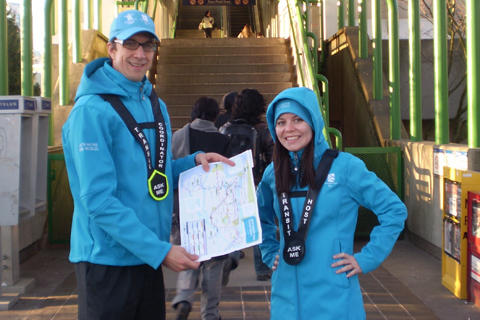TransLink’s Olympic story, part 3: the transit host program
TransLink’s Olympic story, part 3: the transit host program
The Olympics arrive in February, and TransLink has the huge task of helping people travel during the Games. So here’s a series of articles illustrating the challenge and how we’re preparing to handle it. This article focuses on the transit host program, helping people find their way on transit during the Games. (Check out past articles on TransLink’s overall Olympic strategy, and the Transportation Management Centre).

During the Olympic period, thousands of visitors and residents will use Vancouver transit to reach their destinations. And for new and old riders alike, a friendly face with a wealth of transit knowledge can be a huge help in navigating the system, especially with Olympic traffic changes altering some routes.
That’s why TransLink has developed a transit host program for the Games, which puts knowledgeable staff members at key transit exchanges in Vancouver and Richmond.
Transit hosts will be on hand to assist riders throughout the day, and especially before and after Olympic events.
“It’s an enhanced level of customer service for everyone during the Olympic period,” says Giselle Blackman, manager of human resources for the TransLink Olympic team, and the driving force behind the transit host program.
“But we’ll also have new users, and we want them to have a positive experience on transit. A 30 per cent increase in passengers is expected, and if we can retain even a portion of that, we can build a new customer base.”
The work of a host
|
Where will you find transit hosts? Every SkyTrain station in downtown Vancouver Plus: – Main Street-Science World – Commercial-Broadway – 29th Avenue – Broadway-City Hall – King Edward – Bridgeport – Aberdeen – Richmond-Brighouse – UBC bus loops – Lonsdale Quay – Phibbs Exchange – Pacific Coliseum – Richmond Oval |
Around 210 people are part of the host program, drawn from TransLink and Coast Mountain Bus Company staff who are not directly involved in operations, plus board members, St. John’s Ambulance volunteers, and a few folks from UBC.
Each host will be wearing a bright blue jacket and will be posted at select stations and exchanges in the region—the ones where riders will make crucial connections to Olympic events, and where the most help might be needed.
“Given our resources, we had to think hard about how to staff it,” says Giselle. “And we saw that it’s not until riders are closer to their venues that they will need assistance.”
For locations with Olympic events and livesites, shifts run from about 5 a.m. to 1 a.m., with at least two hosts present at any time. Other areas that are less busy will only have hosts there two hours before an Olympic event, and one hour afterward.
“Mostly because once a visitor has gone to the site, they’ll have a much better idea of how to get back,” Giselle explains.
But the host system is designed to be flexible, too. A host command centre and 22 coordinators will oversee all host activity, and can shift staff around if more help is needed at other locations.
Training and understanding, and a legacy
Transit hosts are working hard to welcome the world and are conscious of doing a good job: they have been through several extensive sessions of training, and a handbook was produced to keep hosts informed about all our services and offerings.
And coordinators have been running through tabletop exercises to identify how to act in emergency situations.
It’s a chance for many staff to step into a front-line role, and Giselle is hoping the experience will have a positive legacy.
“Anthony Hopkins says that every role has a part that sticks with you,” she says.
“Well, I don’t know about what he took from Silence of the Lambs, but in this case, we’re hoping this role will give more staff a sense of what the front line service goes through. You’ll appreciate the front-line folks, and it’s a role play that will have some significance.”






just curious, jhen, what is it that they are wearing over their jackets?
You mean the Ask Me necklaces? Or something else?
[…] The Buzzer blog » TransLink’s Olympic story, part 3: the transit host program buzzer.translink.ca/index.php/2010/01/translinks-olympic-story-part-3-the-transit-host-program – view page – cached The Olympics arrive in February, and TransLink has the huge task of helping people travel during the Games. So here’s a series of articles illustrating the challenge and how we’re preparing to handle it. This article focuses on the transit host program, helping people find their way on transit during the Games. (Check out past articles on TransLink’s overall Olympic strategy, and the… Read moreThe Olympics arrive in February, and TransLink has the huge task of helping people travel during the Games. So here’s a series of articles illustrating the challenge and how we’re preparing to handle it. This article focuses on the transit host program, helping people find their way on transit during the Games. (Check out past articles on TransLink’s overall Olympic strategy, and the Transportation Management Centre). View page […]
[…] it’s just one more way to get transit help if you need it. We will also have transit hosts in blue coats standing at key SkyTrain stations and bus exchanges throughout the Olympic period who can also lend […]